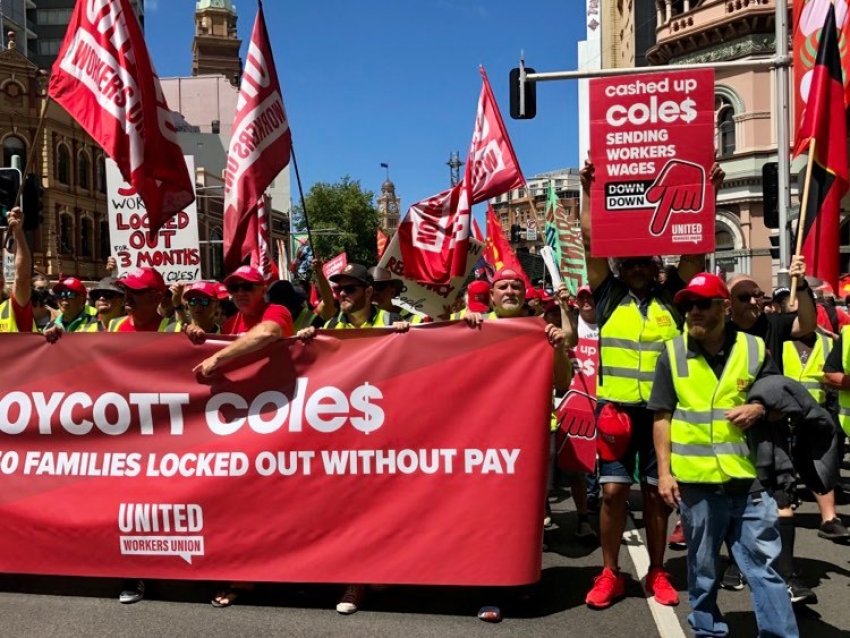
Despite the New South Wales government’s admission that essential workplaces are key sites of COVID-19 transmission, it has done little to address workers’ concerns, leaving the rule-making to bosses.
Now the state government tells us we have to “learn to live with COVID-19”, but essential workers from western and south-western Sydney, who are deemed to be facing the highest risk of COVID-19 infection, have been doing this for months.
Anne*, a member of the United Workers’ Union (UWU), works in a western Sydney warehouse packing fruit, vegetables and refrigerated products for Woolworths. She told Green Left that management had failed to put effective plans in place to prevent the virus from spreading.
“We are called ‘essential workers’, but we are not treated as essential. Lots of people I work with have been close contacts or have contracted [COVID-19] themselves”, she said.
Anne started work in March when there were very few COVID-19 cases. Since then, she said, masks have become mandatory and the site has “gotten much stricter”.
“They enforce mask wearing over the loudspeakers in the warehouse. I have seen people walked off site for having their mask pulled down below their nose. The work is very physical and exhausting, and we can be fired if we don’t work fast enough. Sometimes workers pull their masks down to catch their breath.”
Because she is an essential worker, Anne must take a mandatory swab every three days. “At first, we had to go to one of the testing centres nearby. But then they introduced on-site testing, which was easier.”
More recently, rapid anti-gen testing has been introduced and workers are tested at the beginning of every shift.
Anne told me about a close encounter with an infected worker. “Recently, I was in the waiting room to get tested. The chairs are separated, but only by a metre or so … The nurse came out and told the person next to me that he was positive and needed to be taken for more testing.
“I was worried because I had only just had my second vaccination and wasn’t sure if I would be protected.”
Anne raise her concerns with a manager and was told it “should be alright” because they were both wearing masks. She was told to continue working.
“It would’ve been really bad if I had caught [COVID-19] and then spread it around the site”, she said.
The next day she noticed the chairs in the testing room had been moved further apart.
Another incident, common in many workplaces, was when a fire alarm went off and the entire crew gathered “in one small corner” of the warehouse. “We were all standing there bunched together and I was just thinking if one of us has [COVID-19] I could easily get it. Surely they should have thought of a safer way to respond?”
The UWU said on August 5 it was aware of at least eight sites where workers have been exposed to the virus but had not been contacted by NSW Health.
Woolworths introduced rules on September 6 requiring all workers to have at least one dose of a COVID-19 vaccine. Anne said vaccine hesitancy was not strong, but “many workers haven’t got their vaccines because they haven’t been able to”.
Workers work long hours, including late night and early morning shifts, and many have families and other commitments. Others, she said, are confused by the change in vaccine recommendations or the lack of information in their language.
“There are probably a few who don’t want the vaccine”, she said, “but most have just not gotten around to it”. Anne has had her two doses.
“We are constantly being asked to do overtime to make up for the staff shortages. I already work six days a week and I get calls on my day off asking if I can come in. It’s exhausting.”
Shockingly, Woolworths has now introduced wristbands that track the whereabouts of workers throughout the warehouse and beeps when workers are too close together. “It means if anyone gets sick, the bosses can see who we have worked close to and who might be at risk”, Anne said. “But it also means when we are in the lunch room they’re just constantly beeping.”
Workers have been given specific times they can take breaks and they can only to eat at specified tables. They have also been barred from eating in the outside smoking area.
Anne, a public housing tenant, was not given a choice about where she lived so is living far away from family. The restrictions in specific local government areas (LGA) with high cases means that she is unable to visit anyone, even with the “singles bubble” introduced on August 21.
“I have to travel from one LGA with loads of cases to another and I can’t see anyone. As the lockdown has gotten stricter I see more and more police on the roads; it’s stressful even though I know I am allowed to go to work.”
As COVID-19 cases continue to rise at essential workplaces, workers must be empowered to make decisions to ensure their safety at work and governments must enact paid pandemic leave.
[*Anne is a pseudonym.]